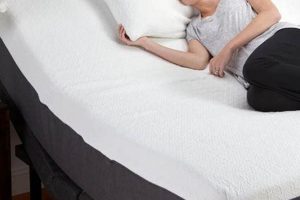The selection of sleeping surfaces that prioritize both superior comfort and environmental responsibility is gaining traction. These products differentiate themselves by employing sustainable materials and manufacturing processes, aiming to minimize ecological impact throughout their lifecycle. Examples include mattresses constructed from organic cotton, natural latex derived from rubber trees, and recycled steel springs, contrasting with conventional options that may rely on petroleum-based foams and resource-intensive production methods.
The significance of such products stems from growing consumer awareness regarding the environmental consequences of traditional manufacturing. Benefits encompass reduced reliance on non-renewable resources, decreased greenhouse gas emissions during production, and the minimization of harmful chemicals present in the final product, contributing to a healthier sleep environment. Historically, the mattress industry has faced scrutiny for its waste generation and use of potentially toxic substances. The current shift towards more ecologically sound practices reflects an evolving understanding of sustainability and its importance in product development.
The following sections will delve into the specific criteria for evaluating these environmentally conscious sleeping solutions, exploring the diverse range of materials utilized, scrutinizing certification standards, and providing guidance on making informed purchasing decisions that align with individual needs and ecological values.
Guidance on Selecting Environmentally Sound Sleeping Surfaces
The following outlines key considerations for those seeking to procure sleeping surfaces that minimize their environmental footprint and promote a healthier sleep environment.
Tip 1: Material Composition Examination: Scrutinize the constituent materials. Opt for mattresses utilizing certified organic cotton, natural latex (sourced from sustainably managed rubber tree plantations), wool, and recycled steel components. Avoid options containing polyurethane foam, volatile organic compounds (VOCs), and chemical flame retardants.
Tip 2: Certification Verification: Prioritize mattresses bearing reputable third-party certifications. Examples include Global Organic Textile Standard (GOTS) for organic textiles, Global Organic Latex Standard (GOLS) for organic latex, and CertiPUR-US for foam products meeting stringent emissions standards. These certifications provide assurance regarding the product’s environmental and health safety credentials.
Tip 3: Manufacturing Process Assessment: Research the manufacturer’s environmental practices. Look for companies that demonstrate a commitment to reducing waste, minimizing energy consumption, and implementing sustainable sourcing practices throughout their supply chain.
Tip 4: Durability and Longevity Considerations: Select a mattress designed for extended use. A durable mattress reduces the frequency of replacement, thereby minimizing waste. Consider factors such as construction quality, material resilience, and warranty coverage.
Tip 5: End-of-Life Disposal Planning: Inquire about the mattress’s recyclability or potential for donation. Some manufacturers offer take-back programs or partnerships with recycling facilities. Alternatively, explore options for donating the mattress to charitable organizations.
Tip 6: VOC Emission Evaluation: Ensure the mattress meets low VOC emission standards. Look for certifications like GREENGUARD Gold, which indicates that the product has been tested for thousands of chemicals and VOCs and meets stringent emission limits.
Tip 7: Flame Retardant Alternatives Investigation: Investigate the type of flame retardants used. Opt for mattresses using natural flame retardants like wool or silica, avoiding those containing harmful chemicals such as PBDEs or boric acid.
Adherence to these guidelines will facilitate a more informed selection, aligning purchasing decisions with environmental responsibility and promoting a healthier sleep environment.
The subsequent section will address common misconceptions surrounding these sleeping solutions and provide additional resources for further research.
1. Material Sustainability
Material sustainability constitutes a cornerstone in the construction of ecologically sound mattresses. The selection of resources directly influences the environmental footprint of the final product. For example, the use of conventional cotton, heavily reliant on pesticides and water-intensive irrigation, contrasts starkly with organic cotton, which is cultivated using methods that minimize environmental harm. Similarly, natural latex, derived from sustainably managed rubber tree plantations, presents a renewable alternative to petroleum-based polyurethane foams. The utilization of recycled steel for mattress springs further reduces the demand for virgin materials and minimizes energy consumption associated with steel production.
The importance of material sustainability extends beyond mere resource conservation. It also encompasses the reduction of harmful chemicals within the sleep environment. Conventional mattresses often incorporate synthetic materials treated with chemical flame retardants and containing volatile organic compounds (VOCs). These substances can off-gas over time, potentially impacting indoor air quality and posing health risks. By prioritizing natural and sustainably sourced materials, mattresses can minimize exposure to such harmful chemicals, promoting a healthier sleep surface. A real-world example is the increasing consumer preference for mattresses made with wool, a natural flame retardant and moisture regulator, thereby avoiding the need for synthetic chemical treatments.
Understanding the link between material sustainability and mattresses has practical significance for consumers seeking to make informed purchasing decisions. By scrutinizing the material composition of mattresses and prioritizing those made from sustainably sourced resources, individuals can actively contribute to reducing environmental impact. Furthermore, this awareness encourages manufacturers to adopt more responsible sourcing practices, driving innovation in the development of eco-friendly materials. In conclusion, material sustainability is not merely a desirable attribute, but a critical component of ecologically mindful mattresses, contributing to both environmental preservation and improved consumer health.
2. Certifications and Standards
The presence of credible certifications and adherence to recognized standards constitute a crucial aspect in determining the environmental responsibility of a mattress. These verifications provide independent validation of claims made by manufacturers regarding the sustainability and safety of their products. Certifications act as a filter, allowing c
onsumers to distinguish between mattresses that genuinely prioritize ecological concerns and those that engage in greenwashing or unsubstantiated marketing practices. The cause-and-effect relationship is evident: rigorous certification standards enforce stricter manufacturing processes, leading to a decrease in environmental impact. Examples of such certifications include the Global Organic Textile Standard (GOTS) for organic textiles used in mattress covers and fillings, the Global Organic Latex Standard (GOLS) for organic latex foam, and CertiPUR-US for polyurethane foam, which ensures low emissions and absence of harmful chemicals.
These certifications often involve comprehensive testing and auditing of materials and manufacturing processes. For instance, the GOTS standard verifies that textiles are produced using ecologically and socially responsible methods, from the harvesting of raw materials to environmentally sound manufacturing practices. Similarly, CertiPUR-US certified foams are analyzed for VOC emissions, prohibited phthalates, and ozone depleters. The practical application of understanding these standards lies in the consumer’s ability to confidently select mattresses that align with their environmental values. Without such standardized benchmarks, consumers would be reliant solely on manufacturer claims, which may lack transparency or independent verification. For example, a mattress labeled as “eco-friendly” without supporting certifications offers minimal assurance of its true environmental credentials.
In conclusion, certifications and standards provide essential frameworks for assessing the ecological attributes of mattresses. They establish verifiable criteria and promote transparency in the industry. The challenge lies in consumer awareness and understanding of the different certification schemes. Further, it is crucial to ensure that certification bodies maintain their independence and rigor to uphold the integrity of the system. Ultimately, robust certification programs are indispensable for fostering confidence in the market and encouraging wider adoption of sustainable practices within the mattress industry.
3. Manufacturing Ethics
Ethical manufacturing practices constitute an integral component of any product claiming to be ecologically sound. In the context of sleeping surfaces, the production processes, labor conditions, and overall corporate responsibility significantly impact the “best mattress eco friendly” status. The cause-and-effect relationship is direct: ethically dubious manufacturing undermines even the most sustainably sourced materials. For instance, a mattress utilizing organic cotton cultivated in a fair-trade environment loses its ethical standing if the subsequent manufacturing process involves exploitative labor practices or generates excessive pollution. Manufacturing ethics ensures a holistic approach to sustainability, encompassing not only environmental considerations but also social responsibility.
The importance of ethical manufacturing extends beyond simple compliance with labor laws. It encompasses a commitment to minimizing environmental impact through responsible waste management, reduced energy consumption, and the avoidance of harmful chemicals throughout the production process. A practical example is a mattress manufacturer that invests in renewable energy sources to power its facilities and implements closed-loop water systems to minimize water usage and pollution. Furthermore, transparency in the supply chain is paramount. Consumers should have access to information regarding the origin of materials and the working conditions of those involved in the production process. This necessitates traceability and accountability at every stage, from raw material extraction to final product assembly. The practical significance of understanding these practices empowers consumers to make informed purchasing decisions that support ethical and sustainable businesses. Consider the difference between a mattress assembled in a factory adhering to fair labor standards and one produced in a facility with documented violations of worker rights; the choice reflects a commitment to both environmental and social responsibility.
In summary, manufacturing ethics are not a peripheral consideration but a fundamental aspect of evaluating the overall ecological soundness of mattresses. The industry faces challenges in ensuring consistent implementation of ethical practices across global supply chains. However, increased consumer awareness and pressure can incentivize manufacturers to prioritize responsible production methods. Ultimately, a truly ecologically responsible mattress embodies a commitment to both environmental stewardship and social justice, reflecting a holistic approach to sustainability.
4. Durability and Longevity
Durability and longevity are intrinsically linked to the concept of ecologically sound sleeping surfaces. A mattress exhibiting extended usable life inherently reduces the frequency of replacement, thereby minimizing its overall environmental impact. The cause-and-effect relationship is straightforward: a durable product necessitates fewer resources over time compared to its less resilient counterparts. The importance of durability as a component of “best mattress eco friendly” is amplified when considering the energy expenditure and waste generated during manufacturing, transportation, and disposal processes. A frequently replaced mattress contributes significantly to landfill waste, requiring additional resources for decomposition or incineration. As a real-life example, a mattress constructed with high-quality, sustainably sourced latex and a robust coil system can outlast a conventional polyurethane foam mattress by several years, resulting in a demonstrable reduction in environmental burden. The practical significance of this understanding lies in shifting consumer focus from short-term cost savings to long-term value and environmental responsibility.
The materials used in the construction significantly influence a mattress’s durability. High-density materials, such as natural latex or individually wrapped coils, are generally more resistant to wear and tear than lower-density alternatives. The construction method also plays a crucial role. Reinforced edges, for instance, prevent sagging and maintain structural integrity over time. Further, the type of use affects longevity. A mattress subjected to consistent heavy loads will likely degrade faster than one used less frequently or by individuals with lighter body weights. Proper care and maintenance, such as regular rotation and the use of a mattress protector, can also extend its lifespan. Consider a mattress with a modular design, where individual components can be replaced rather than requiring a complete replacement; this approach offers a practical and environmentally sound solution for extending product lifespan. For example, if the comfort layer of a mattress degrades after several years, the entire mattress does not need disposal; a new comfort layer can simply be installed.
In conclusion, durability and longevity are not merely desirable attributes but essential characteristics of an ecologically responsible mattress. The focus on extended product lifespan directly translates to a reduction in resource consumption and waste generation. Challenges remain in educating consumers about the long-term benefits of investing in higher-quality, more durable sleeping surfaces. Additionally, manufacturers need to prioritize sustainable de
sign and construction practices that promote longevity, offering consumers the ability to reduce their environmental footprint through informed purchasing decisions. Prioritizing “Durability and Longevity” is vital to achieving “best mattress eco friendly.”
5. Health Impact Reduction
Minimizing adverse health effects constitutes a core objective in the development and selection of environmentally responsible mattresses. The emphasis on health impact reduction stems from concerns regarding potential exposure to harmful substances present in conventional sleeping surfaces, ranging from volatile organic compounds (VOCs) to chemical flame retardants. These substances can contribute to various health issues, necessitating a shift towards materials and manufacturing processes that prioritize occupant wellbeing.
- Reduced VOC Exposure
Volatile organic compounds, commonly found in polyurethane foams and adhesives, are known to off-gas from mattresses into the surrounding air. These compounds can trigger respiratory irritation, allergies, and headaches in susceptible individuals. Ecologically sound mattresses utilize materials with low or zero VOC emissions, such as natural latex, wool, and plant-based foams. Independent certifications, such as GREENGUARD Gold, verify compliance with stringent VOC emission standards. For example, a mattress certified GREENGUARD Gold assures consumers that it has been tested for over 10,000 chemicals and VOCs and meets rigorous emission limits, thus reducing the risk of adverse health effects.
- Elimination of Chemical Flame Retardants
Conventional mattresses often contain chemical flame retardants, some of which have been linked to endocrine disruption, developmental problems, and even cancer. The transition to non-toxic alternatives, such as wool or silica-based barriers, represents a significant advancement in health impact reduction. These natural flame retardants effectively meet flammability standards without posing the same health risks associated with their chemical counterparts. An instance of this includes a mattress manufacturer who completely avoids the use of chemical flame retardants, instead, using tightly woven natural fibers that act as a flame barrier.
- Allergen Mitigation
Mattresses can accumulate dust mites, mold, and other allergens over time, contributing to respiratory problems and allergic reactions. Materials like natural latex and wool possess inherent antimicrobial and hypoallergenic properties, inhibiting the growth of these allergens and promoting a cleaner sleep environment. An example is the common use of wool in mattress construction, which is both naturally flame-retardant and moisture-wicking, reducing the likelihood of mold and dust mite proliferation.
- Promotion of Ergonomic Support
A mattress that provides adequate spinal support and pressure relief can alleviate back pain, improve sleep quality, and contribute to overall musculoskeletal health. While ergonomic support is not solely a function of environmentally friendly materials, the combination of sustainable materials and thoughtful design can enhance these benefits. Examples include mattresses combining natural latex with pocketed coils, conforming to the body’s contours while minimizing motion transfer and promoting proper spinal alignment.
The aforementioned facets demonstrate the interconnectedness between “Health Impact Reduction” and the selection of ecologically responsible sleeping surfaces. By minimizing exposure to harmful chemicals, mitigating allergens, and promoting ergonomic support, these mattresses offer a pathway to improved wellbeing. The growing awareness of these health considerations is driving consumer demand for mattresses that prioritize both environmental and personal health, encouraging manufacturers to innovate and adopt more sustainable and health-conscious practices.
Frequently Asked Questions Regarding Ecologically Sound Mattresses
The following addresses common inquiries concerning sleeping surfaces designed to minimize environmental impact and promote healthier sleep environments. The information provided aims to clarify misconceptions and offer guidance on making informed purchasing decisions.
Question 1: How does a mattress qualify as “eco-friendly”?
A mattress achieves this designation through the utilization of sustainably sourced materials (e.g., organic cotton, natural latex), the implementation of environmentally responsible manufacturing processes (e.g., reduced waste, minimized VOC emissions), and the absence of harmful chemicals (e.g., chemical flame retardants). Third-party certifications (e.g., GOTS, GOLS, CertiPUR-US) provide independent verification of these attributes.
Question 2: Are ecologically responsible mattresses necessarily more expensive?
While the initial cost may be higher compared to conventional options, factors such as increased durability and reduced healthcare costs associated with exposure to harmful chemicals can offset this difference over the lifespan of the product. Furthermore, the long-term environmental benefits represent an additional value proposition.
Question 3: Do “eco-friendly” mattresses compromise on comfort or support?
Modern ecologically sound mattresses can deliver comfort and support comparable to, or exceeding, that of conventional options. Materials like natural latex and memory foam alternatives derived from plant-based oils provide excellent pressure relief and spinal alignment. The key lies in selecting a mattress that suits individual sleep preferences and body type.
Question 4: How can consumers verify the claims made by mattress manufacturers regarding sustainability?
Consumers should prioritize mattresses bearing reputable third-party certifications (e.g., GOTS, GOLS, CertiPUR-US). These certifications involve rigorous testing and auditing processes, providing independent verification of material composition, manufacturing practices, and emissions levels. Absence of these certifications should raise concerns regarding the validity of sustainability claims.
Question 5: What is the expected lifespan of an ecologically responsible mattress?
With proper care and maintenance, an ecologically responsible mattress constructed from durable materials such as natural latex can last 7 to 10 years, or even longer. Factors influencing lifespan include material quality, usage patterns, and maintenance practices (e.g., regular rotation, use of a mattress protector).
Question 6: What disposal options exist for mattresses that have reached the end of their usable life?
Options include mattress recycling programs, donation to charitable organizations, and, in some cases, manufacturer take-back programs. Disposing of mattresses in landfills should be avoided whenever possible due to the environmental burden associated with waste accumulation and decomposition.
In summary, ecologically sound mattresses offer a viable alternative to conventional options, providing both environmental and health benefits. However, careful evaluation of material composition, manufacturing practices, and certification status is crucial for making informed purchasing decisions.
The subsequent section will delve into specific examples of ecologically sound mattress brands and models currently available on the market.
Conclusion
The preceding exploration has delineated the multifaceted as
pects that define a “best mattress eco friendly.” Material sustainability, ethical manufacturing, verifiable certifications, durability, and health impact reduction constitute the crucial pillars supporting the ecological integrity of these products. The transition towards these alternatives represents a tangible step in mitigating the environmental consequences associated with conventional mattress production and consumption.
The decision to invest in an ecologically responsible mattress signifies a commitment to both personal well-being and environmental stewardship. While challenges remain in achieving widespread adoption and ensuring supply chain transparency, the continued pursuit of innovation and responsible practices within the industry holds the potential for a more sustainable future. Responsible consumerism and continued awareness will facilitate this shift, promoting a healthier planet and improved sleep environments for generations to come.





![Top-Rated Best Truck Bed Mattress Options [Guide] Organic & Natural Mattress Buyer’s Guide: Non-Toxic Sleep Solutions Top-Rated Best Truck Bed Mattress Options [Guide] | Organic & Natural Mattress Buyer’s Guide: Non-Toxic Sleep Solutions](https://mattressworldpa.com/wp-content/uploads/2025/07/th-7704-300x200.jpg)
![Top-Rated Best Mattress for Bad Back [Pain Relief] Organic & Natural Mattress Buyer’s Guide: Non-Toxic Sleep Solutions Top-Rated Best Mattress for Bad Back [Pain Relief] | Organic & Natural Mattress Buyer’s Guide: Non-Toxic Sleep Solutions](https://mattressworldpa.com/wp-content/uploads/2025/07/th-7703-300x200.jpg)
